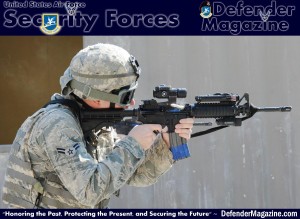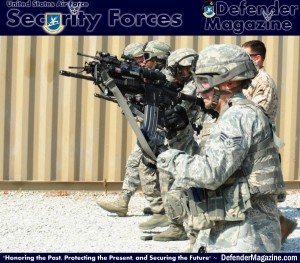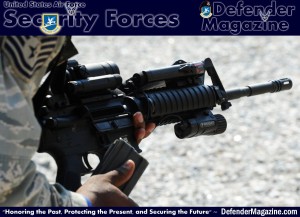
6/26/2012 – LANGLEY AIR FORCE BASE, Va. — The soaked sand-colored T-shirt stuck to the skin under the ceramic plate. A shift of the sling put the loaded M4 carbine on the left side, primed to fire around the wall with maximum cover.
“Move up!”
“Cover!”
“Ready!”
“Moving up!”
The four commands rang out, the Defender rushed to the barricade; ready to take down any adversary.
“Alright, next group,” said the instructor. “Good job, get some water”
The squad moved back to the truck to hydrate, and the next group of security personnel moved up to the starting block, as the 633rd Security Forces Squadron practiced the basics of “Shoot, move, communicate” training at Fort Eustis, Va., June 21.

Before going to Fort Eustis for the live exercise, 633rd SFS members refreshed their memory on proper and efficient methods to fix a weapon jam, reload and transition between weapons, at Langley Air Force Base, Va., June 20.
The controlled environment allowed instructors to work with each individual and their varied methods.
“There are a lot of ways to work with your weapon,” said Staff Sgt. Patrick Gargan, 633rd SFS training instructor, in a brief to the participants. “We all do everything a little different, and that’s fine.”
Once class was finished, every member tried their hand at fixing the most common weapon jams and practiced the basic movements they learned during technical training.
After familiarizing themselves with training, the participants went to Fort Eustis to put the skills to the test.
Implementing a “crawl, walk, run” mentality allowed both the instructors and Security Forces members to evaluate progress and training requirements throughout the entire exercise.
Training at Fort Eustis included moving from cover to cover and practicing the four basic commands that are second nature to all Security Forces personnel, said Gargan.

For each exercise, participants were given “simunition”; aluminum-cased plastic rounds with a colored detergent to determine where a target, or person, was hit.
“These rounds allow force-on-force exercises,” said Gargan. “We can evaluate our troops on how they react under fire.”
Also, the modified ammunition is cheaper than using real rounds but still allows realistic recoil. The rounds themselves are small bits of plastic, allowing for easier clean up and a smaller economic footprint, said Gargan.
Beyond the deployment aspects, there are extraneous purposes for the training.
“It builds camaraderie;” said Timothy Northcutt, 633rd SFS supervisory police officer, “and anytime we get trigger time is a good time.”
Solidarity of the force is important, Northcutt continued. Having the ability to communicate with any other individual with this training can prove invaluable in multiple incidents, such as in the event of an active shooter.
One the most infamous examples of an active shooter scenario occurred in 1999 at Columbine High School, Jefferson County, Colorado. It forced law enforcement to re-evaluate how they handle active shooter scenarios.

“We all remember Columbine,” said Northcutt. “Before we set up a perimeter; now first on scene is first to engage.”
In every case, the basics allow security officials to react immediately.
“It’s muscle memory,” said Senior Airman Stephanie Cardwell, 633rd SFS commander’s executive. “We don’t have time to think, just to react.”
In the end, Northcutt said, this training only further improved the skill of Langley defenders.
“These are high-speed, highly trained people that are responsible for base security,” said Northcutt.
by Airman 1st Class Austin Harvill
633rd Air Base Wing Public Affairs